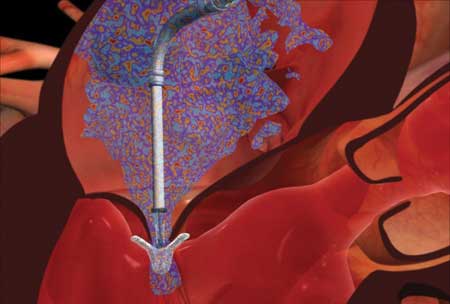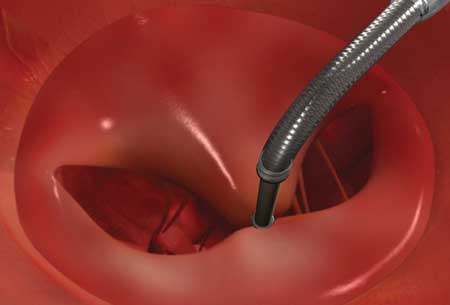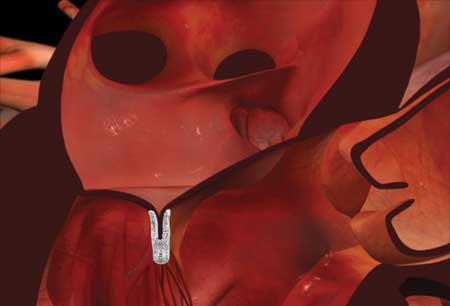The Promise and Challenges of Percutaneous Treatment of MR
Despite encouraging data and the approval of select devices in the EU, the jury is still out on percutaneous strategies for mitral regurgitation in the US.
The short story on percutaneous treatment of mitral regurgitation is that the search for a universally accepted strategy has not yet reached an end. Despite several decades of research — the first direct vision mitral annuloplasty was reported in 1958 — recent setbacks involving the MitraClip leaflet repair system have highlighted ongoing difficulties in this particular branch of interventional cardiology.
Renu Virmani, MD, medical director, CVPath Institute, Gaithersburg, Md., and Cardiology Today Intervention Editorial Board member, noted that one of the key difficulties is in selecting an appropriate patient population for the percutaneous approach.

Renu Virmani
“The biggest need is for patients with functional mitral regurgitation (MR), rather than degenerative MR,” she said. “These patients require so much more attention. They have low ejection fraction and large MR and are not good candidates for surgery, so there is no other recourse.”
Currently, besides the MitraClip (Abbott Vascular), which was tested in the randomized EVEREST II trial and did not garner FDA approval as a result of the data, there are several direct annuloplasty systems in trials, including Mitralign (Mitralign) and the Accucinch (Guided Delivery Systems) devices. The Carillon Mitral Contour System (Cardiac Dimensions) shows promise as a coronary sinus reshaping, or an indirect annuloplasty, device. Mitral valve replacement system Endovalve (Micro Interventional Devices) is in preclinical development, while the CardiAQ (CardiAQ) system, also for mitral valve replacement, is in very early stages of research.
However, despite the influx of percutaneous devices for MR, none are close to FDA approval.

Figure 1. The MitraClip pre-procedure. The MitraClip is one of several percutaneous devices being tested for the treatment of mitral regurgitation.
Images: Abbott; reprinted with permission.

Figure 2. The MitraClip during the procedure.

Figure 3. The MitraClip post-procedure.
Challenges Inherent to MR
Steven F. Bolling, MD, professor of cardiac surgery at the University of Michigan, said that the difficulty in meeting this need may simply be a function of the complexity of MR as a condition. “We are still relatively far away from a device because the mitral valve is a hard space to treat this way,” he said in an interview.

Steven F. Bolling
Virmani agreed. “This is a difficult anatomy to deal with,” she said. “The aortic valve is easy: There are only the leaflet and annulus to deal with. Here, we have the chordae tendinae, the papillary muscles, the left ventricular wall, the leaflet and the annulus, so it is going to be much more difficult to treat.”
According to Carlos E. Ruiz, MD, director, structural and congenital heart disease, Lenox Hill Heart and Vascular Institute of New York, the complexity of the structure lends itself to the surgical approach.
“The surgeons who do the repair plan it not at one single mechanism, but apply total repair techniques to multiple mechanisms, whether they have to do triangular resection, annuloplasty, chordal implants, papillary slings and so on. There is a lot of technology that a surgeon can do during the repair and that is perhaps why their results are so much better.”
Compounding the problem for the percutaneous strategy is the relative newness of the approaches for treating the condition.

Jason H. Rogers
“This is a highly specialized technology,” Jason H. Rogers, MD, director of interventional cardiology in the division of cardiovascular medicine at the University of California, Davis Medical Center, Sacramento, Calif., told Cardiology Today Intervention. “Few clinicians have an advanced understanding of the mechanisms that result in MR. Traditionally, patients with the condition have been sent to surgeons for correction, so now for the first time, cardiologists are having to deal with understanding the mitral valve disease state.”
Rogers said he feels hopeful for systems such as MitraClip to become standard, but he also remains cautious. “Patients feel better. However, we still don’t have level A evidence yet that this technology benefits patients compared with surgery or medical therapy, but rather only level B evidence at this point,” he said.
Patrick L. Whitlow, MD, director of interventional cardiology at the Cleveland Clinic and researcher with EVEREST II, said that previous experience with percutaneous approaches will be beneficial moving forward.
“We have successfully found interventions for the aortic valve and now we’re doing it for MR,” he said. “Together that accounts for a large number of elderly patients in the United States who currently do not have a good treatment option.”
That said, the fact remains that EVEREST II did not achieve the intended goal.
Questionable Study Design
Despite high hopes for the MitraClip, investigators of the EVEREST II study did not gear the trial toward a high-risk population with functional MR. The EVEREST II study randomly assigned patients with mostly degenerative MR and lower surgical risk to either MitraClip therapy or conventional surgery. Moreover, they were unable to make up ground with the subsequent nonrandomized EVEREST II High Risk Study, in which the data were assessed more specifically toward patients with more complex disease.
As a result, MitraClip has not yet gained FDA approval. This, in turn, raised broader questions about percutaneous approaches for treating the condition.
Rogers acknowledged some merits of the MitraClip system, but suggested that EVEREST II might have faced difficulties from the outset that led to it failing to meet FDA approval.
“The trial was not designed the way it should have been designed,” Rogers said. “The trial involved mostly healthier patients at lower risk. The approval pathway should be in high-risk patients. The FDA viewed it as a loss for the clip.”
Bolling echoed Rogers. “This device is more appropriate for patients with functional disease rather than degenerative disease,” he said. “This should not have been an all-comers trial.”

Scott Lim
Scott Lim, MD, pediatric and adult cardiologist at the University of Virginia, Charlottesville, Va., and investigator for EVEREST II, noted that the FDA was involved in the design of the trial, but the administration was ultimately unsatisfied with the result. However, he remains optimistic.
“The MitraClip is a good system,” he said. “What we are doing now is trying to refine what the right indication for this therapy ought to be.”
Lim agreed that the device is likely to be more effective in high-risk patients; however, this patient population presents its own difficulties.
“The disease process of the mitral valve affects different people differently,” he said. “It is not as cut and dried as patients living or dying. It is occasionally this clear cut, but often they live with HF and symptoms, or they dwindle. These are difficult outcome measures to get a handle on. This is why the FDA and the device companies have not been able to come up with clear results.”
MitraClip was also defended by Whitlow. He said that the clip “appears to be efficacious in reducing mitral regurgitation. Not quite as much as surgery, but still it’s efficacious.”
Whitlow said results of the high-risk study indicated that the device was safe for patients who were too sick for surgery. “There was not an increase in mortality compared with what would be expected in these patients treated medically,” he said.
Rogers acknowledged the safety factor. “The clip is safer mostly because fewer transfusions are required,” he said. “Proponents of the clip say it is safer, and that it is almost as effective as surgery, but surgery was more effective at reducing MR.”
According to Whitlow, there are positives that can be taken from EVEREST II. “It has been shown that hospital stays are shorter, recovery to full activities for the patient is much faster and the patients certainly like it,” he said. “The remaining issues include the long-term durability. We just don’t have long-term follow up yet.”
COAPT
The long-term follow-up to EVEREST II may prove less important than the results of the COAPT trial, which will test the MitraClip in high surgical risk patients.
“COAPT will be starting this year, and the results of that trial should give us a definitive answer,” Whitlow said. “If the device doesn’t get approved beforehand, I expect it will be approved once the randomized trial is over. It will take about 3 years.”
“Gregg W. Stone, MD, who has a wealth of experience in clinical trial design, has been brought on board as principal cardiology investigator of the COAPT trial, and Michael Mack, MD is the principal surgeon investigator,” Rogers said. He added that the study will be conducted in patients with lower ejection fraction, who are at high risk for surgery. “This may be a clearer pathway to FDA approval.”
Lim said that COAPT will involve patients who are non-operative candidates with functional regurgitation.
“In this patient subgroup, medicine has had limited benefit, and surgery has not been an attractive option,” he said. “This is an area where there is an unmet therapeutic need.”
Other Percutaneous Devices
Whitlow noted that the Carillon device has received the CE mark but is still under investigation in the United States. “It is an indirect annuloplasty device,” he said. “The early results have been favorable and the studies are continuing.”
Another possible contender is the Mitralign system, which, according to Whitlow, puts pledgeted sutures percutaneously through the ventricle going upward into the annulus; the sutures are then drawn tight to do a direct annuloplasty. “The device is still under development,” he said.
Virmani is hopeful for the Mitralign system. “Mitralign may ultimately compete with the MitraClip,” she said.
The Millipede (Millipede) system is also currently in preclinical development. The device is designed to shrink annular size and treat tricuspid or mitral regurgitation. “A device like this attempts to recreate the gold standard of surgery percutaneously,” Bolling said. “But, again, it is far from approval.”
Additionally, this past June, the CardiAQ system, the world’s first self-conforming and self-anchoring technology for transcatheter mitral valve replacement, was successfully implanted for the first time in an 86-year-old man with severe MR (4+) in Copenhagen, according to a press release.
However, in the race to bring a percutaneous strategy to practice in the United States, the MitraClip appears the closest to the finish line. “MitraClip is here and it is being used,” Bolling said. “This device will be worthwhile for certain patients, but we just have to continue to try to answer the question of who it can help.” – by Rob Volansky
References:
Feldman T. N Engl J Med. 2011;364:1395-1406.
Whitlow PL. J Am Coll Cardiol. 2012;10;59:130-139.
Disclosure: Dr. Bolling has intellectual property with and receives royalty from Edwards Lifesciences; Dr. Lim is a consultant for and has received research funding from Abbott Vascular; Dr. Rogers has consulted for Biosense Webster, Boston Scientific, Medtronic, Millipede, Mitralign, St. Jude Medical and Volcano Corp.; Dr. Ruiz reports no relevant financial disclosures; Dr. Virmani has been involved in the development of several percutaneous mitral regurgitation devices, including MitraClip and Mitralign, but reports no relevant financial disclosures; Dr. Whitlow reports that his institution received research support for the EVEREST trials.
